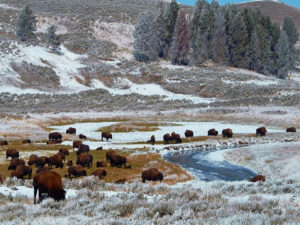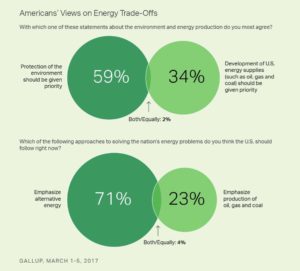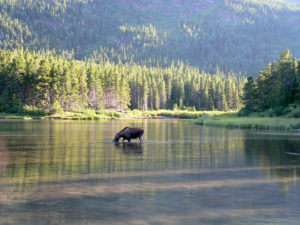We have much more to do and your continued support is needed now more than ever.
Drastic Federal Budget Cuts Would Exacerbate America’s Wildlife Crisis

The President’s Fiscal Year 2018 (FY18) Budget Request includes unprecedented cuts to conservation funding, which would debilitate crucial programs that protect and restore wildlife habitat, ensure access to public lands, promote outdoor recreation, and safeguard clean air and clean water.
“America’s wildlife are facing an unprecedented crisis, battered by challenges of habitat degradation and impaired water quality, exacerbated by disease, drought, invasive species, and climate impacts, all at a scale inconceivable thirty years ago,” Collin O’Mara, NWF’s president and CEO, said today in a statement. “Nearly a decade of budget austerity has done little to ease this crisis and the massive cuts outlined in this budget would be the opposite of what scientists say is needed to reverse America’s wildlife decline.”

To put these environmental budget cuts in context, the federal budget has continued to fund the Natural Resources and Environment portion of the budget (“Function 300”) to only slightly more than one percent of the total federal budget – and this portion has been steadily declining over the years. Taking such drastic cuts out of this already small fraction (again, one percent) of federal spending for FY18 is not an accurate reflection of the value America’s lands, waters, and wildlife have – both intrinsically, and economically. Our investment in these resources should reflect this value.
The intent of the budget request, like every year’s Presidential budget request, is to provide suggestions to Congress on the next fiscal year’s spending levels (which will begin on October 1). But this budget request is merely that – a request – and it is now up to Congress to decide how closely to follow these extreme budget cuts to important conservation programs – cuts that could be devastating for our nation’s wildlife.
AMERICANS CARE ABOUT WILDLIFE AND THE ENVIRONMENT – AND THE ECONOMY SHOWS

If you’re wondering if and how much Americans care about wildlife and the environment, look no further than outdoor recreation’s impact on the economy: the outdoor recreation industry annually contributes $646 billion to our national economy, supports 6.1 million direct American jobs, and generates $80 billion in federal, state, and local tax revenue, according to the Outdoor Industry Association. Its economic impact is almost as much as the pharmaceuticals and automotive industries combined. And for directly wildlife-related economic impact, the most recent National Survey of Fishing, Hunting, and Wildlife-Associated Recreation shows us over 90 million Americans spend $144.7 billion in a single year on fishing, hunting, and wildlife-watching alone. Furthermore, according to a January 2017 poll, 88 percent of Americans believe that protecting the environment should be an important priority for the current Administration and Congress, with 55 percent feeling it should be a top priority.
Even Congress has acknowledged the significant economic importance of America’s wildlife and wild places: just last November, Congress passed the Outdoor Recreation Jobs and Economic Impact Act of 2016 (H.R. 4665). This law now ensures the outdoor recreation economy is measured by the federal government and accounted for as part of the national gross domestic product (GDP), formally recognizing the economic importance of our outdoor recreation economy and the lands, waters, and wildlife that support it.
Put another way: budget cuts to federal programs that support and protect these natural resources would not only threaten our environment and the wildlife we love, but would also threaten America’s economy.
WHAT WOULD DRASTIC DECREASES IN FEDERAL SPENDING MEAN FOR WILDLIFE AND THEIR HABITATS?
Department of Interior (DOI)

Just last week, U.S. Department of the Interior Secretary Ryan Zinke hailed 331 million recreation visits to America’s national parks in 2016 – a third consecutive all-time attendance record for the National Park Service and up 7.7 percent over 2015. We see time after time that America’s outdoor heritage is truly a bipartisan priority – from 1906, with Teddy Roosevelt’s legacy of the Antiquities Act creating and protecting national monuments, all the way to today in 2017, with a bipartisan bill introduced just last week to permanently reauthorize funding for the Land and Water Conservation Act.
The President’s budget, which cuts the Department of Interior by 12 percent, does not reflect our long-standing investment in America’s natural heritage. It would inhibit the DOI’s ability to purchase new public lands, and would cut the National Wildlife Refuge Fund, National Heritage Areas, and Abandoned Mine Lands grants – all programs that help restore and protect important wildlife habitat and enhance opportunities for sportsmen and other outdoor enthusiasts.
National Oceanic and Atmospheric Administration (NOAA)
Although the National Oceanic and Atmospheric Administration (NOAA) currently does not have a specific funding number, the President’s 2018 Budget requests a 16 percent decrease in the budget for the Department of Commerce, the department which houses NOAA, and specifically asks to zero out over $250 million in targeted NOAA grants and programs supporting coastal and marine management, research, and education. But NOAA’s work is a critical part of our federal investment in environmental protection and research, and luckily U.S. Senators from both parties have already gone on record expressing the need to continue to fund the important work NOAA does.
Included in this important work are NOAA’s coastal adaptation and resilience programs, which fund efforts to safeguard our nation’s wildlife from a rapidly changing world, like NWF’s work to build a stronger coastline and protect communities and wildlife by restoring native dunes.

Additionally, NOAA’s environmental education grants fund projects across the country that engage students in environment-based learning. From the Environmental Literacy Program to the Bay Watershed Education and Training (B-WET) program, these crucial NOAA environmental education programs aid efforts to foster the next generation of environmental stewards.
Environmental Protection Agency (EPA)
Despite 63 percent of America having a favorable view of the Environmental Protection Agency, the EPA’s budget would take the hardest hit of any agency. Its 31 percent budget cut would eliminate 3,200 staff and discontinue a number of programs critical to the survival of America’s wildlife – including the Clean Power Plan, international climate change programs, climate change research and partnership programs, and related efforts. Yet these programs play a critical role in mitigating the impact of climate change on wildlife – from dwindling salmon runs in the West to drastically lower moose populations in the North and Northeast.

More than 85 percent of America agrees that climate change is a problem, and a Gallup poll from just this week indicates that 59 percent of Americans say protecting the environment should be a higher priority than development of U.S. energy supplies, with 71 percent who believe emphasis on alternative energy instead of fossil fuel production is the approach the U.S. should follow to solve the nation’s energy problems. Even Members of Congress have introduced a bipartisan resolution on the need to commit to working on economically viable solutions that address the risks of climate change.

As for the EPA’s role over protecting our nation’s water resources, while we were pleased to see a commitment to drinking and wastewater infrastructure by raising State Revolving Funds and maintaining the Water Infrastructure Finance and Innovation Act program, these potential water quality gains are nullified by the elimination of funding for regional efforts such as the Great Lakes Restoration Initiative, the Chesapeake Bay, and other geographic programs. Defunding these widely-successful restoration programs is threatens wildlife and wildlife habitat, and threatens Americans’ access to drinkable, fishable, and swimmable water.
FEDERAL BUDGET MUST PRIORITIZE WILDLIFE AND CONSERVATION
 The math adds up. Indiscriminate cuts to crucial conservation programs are not the solution. We need to invest in America’s wildlife and wild places – and not slash the federal budget of the funding that protects these environmentally and economically significant resources. NWF and our partners have requested the strongest possible funding levels for America’s wildlife, fisheries, lands, waters, cultural resources, and their associated economic and recreational benefits. We must prioritize wildlife and conservation now more than ever.
The math adds up. Indiscriminate cuts to crucial conservation programs are not the solution. We need to invest in America’s wildlife and wild places – and not slash the federal budget of the funding that protects these environmentally and economically significant resources. NWF and our partners have requested the strongest possible funding levels for America’s wildlife, fisheries, lands, waters, cultural resources, and their associated economic and recreational benefits. We must prioritize wildlife and conservation now more than ever.
To learn more, check out our blog series outlining why such drastic federal budget cuts would intensify America’s wildlife crisis, including:
MAKE YOUR VOICE HEARD: Join us in calling on Congress to ensure robust funding for wildlife and conservation in FY18.
Take ActionTell your Members of Congress: Don’t Let Drastic Budget Cuts Devastate Wildlife





















